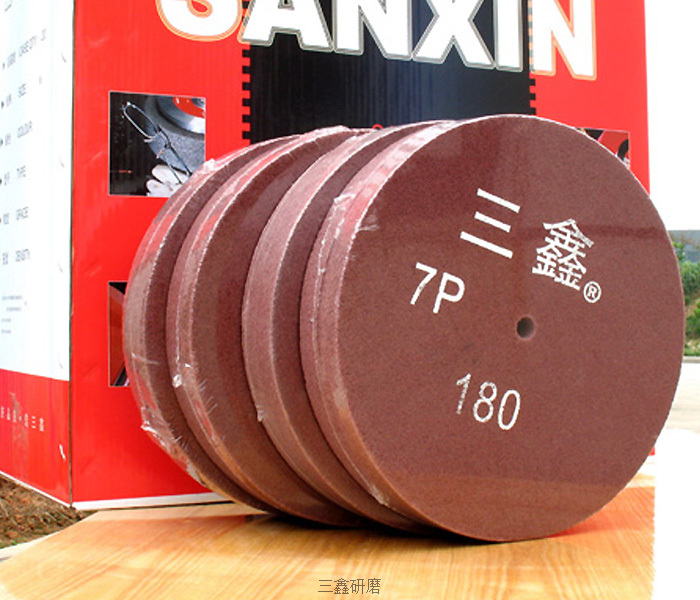Cut & Polish Wheels
Product Description:
It has strong cutting force, and is applicable to finishing and grinding of hardware such as knifes and stainless steel, can partially supersede traditional fabric grinding wheel, sponge fabric grinding wheel and plastic fabric wheels. It can cover the course lines left by gauze belt and is effective to deburr and sharpen castings. Also, the lines after grinding is fine and graceful. It can be used for manual or automatic grinding.
Product Application:
Range of application:
1. Grinding of stainless steel (requiring cutting)
2. Finishing and grinding of metals and various hardware work pieces
3. Clearing of welding points
4. Finishing, grinding and polishing of various castings
5. Finishing and grinding of auto and motorcycle fittings
Hub:
1) Hub materials: mainly two kinds, one is aluminum hub, the other is steel hub.
2) Hub surface treatment involves below main types of Sanxin products
Main two kinds: small grinding disk 100*15-1518, grey; type C grinding wheel, 8*2*7PC-180#
Use method and technical parameters:
Small grinding disc: mainly used on angle grinder for partial finishing and grinding of hubs. It is operated manual, so it is flexible and convenient. Generally there are no special requirements.
Type C grinding wheel: 8*2*7PC-180#, used on common sand grinder for surface finishing and grinding of hubs.
6. Pre-plating treatment
As the plated parts are mostly castings and forges before plating, surface brightness is low, so certain surface treatment shall be done before plating. General methods are given as below:
The method of adhering sand on fabric wheel is adopted, generally involving tow or three procedures:
1) Course polishing treatment; Generally the surface of castings or forges is rough with many burrs, this procedure is conducted by using large grain size sand to remove burrs and conduct basic finishing of surface. Usually, 80# or 120# grain size is adopted.
2)Transition treatment: It is mainly for transit from course polishing to fine polishing. Course sands are adopted for course polishing and fine sands are chosen for fine polishing, so for this transition treatment, the grain size between the two kinds, i.e. 180# or 220# is selected.
3) Fine polishing treatment: It is further polishing treatment based on above procedure, mainly in purpose of promoting adhesion of castings on the plating, increase levelness of plated surface and increase product finish rate. Generally 280# or 320# is selected.
Owing to low cost, this method is greatly recognized by vast plating surface treatment plants. However, it needs continuous adhesion of sands and drying, the procedure is complicated, leading to low efficiency.
Method 1:use non-woven grinding wheel, i.e. Sanxin type C finishing grinding wheel of polishing wheel to supersede above procedures.
Specific specifications and types are as below:
Course polishing treatment: 12*2*7PC-120# or12*2*9PC-120#
Transition treatment:12*2*7PC-180# or12*2*9PC-180#
Fine polishing treatment: 12*2*7PC-240#/320# or 12*2*9PC-240#/320#
Advantages of non-woven grinding wheel: higher efficiency and less complicated procedures: adding adhesives, bonding sands and drying, etc; moreover, easier to store raw materials, higher finish rate of plated products, stronger surface adhesion and better surface brightness. As the overall replacing cost is a little higher than fabric wheel sand, it will depend on if customers recognize the method. Otherwise, it is suggested to adopt below method:
Method 2: use fabric wheel to bond sand for pretreatment, i.e. course polishing plus transition treatment followed by fine polishing with non-woven grinding wheel, i.e. 12*2*7PC-240# or 12*2*9PC-240#.
This method can not only improve product quality but also reduce cost.
Manufacturer’s suggestions:
1. Metal derusting and clearing of welding points, as well as finishing and grinding of various castings.
2. It will greatly facilitate plating by using grinding wheel for polishing of hardware before plating, and the plating effect will be also dramatically promoted (the finishing grinding wheel does not require polishing paste like using fabric wheel, less residue are left on the surface of hardware workpiece, and polishing effect are more even, hence follow-up adhesion is enhanced).
3. To achieve best effect, different kind of treatment shall be combined, first using large grain size wheel and then use small grain size wheel.







